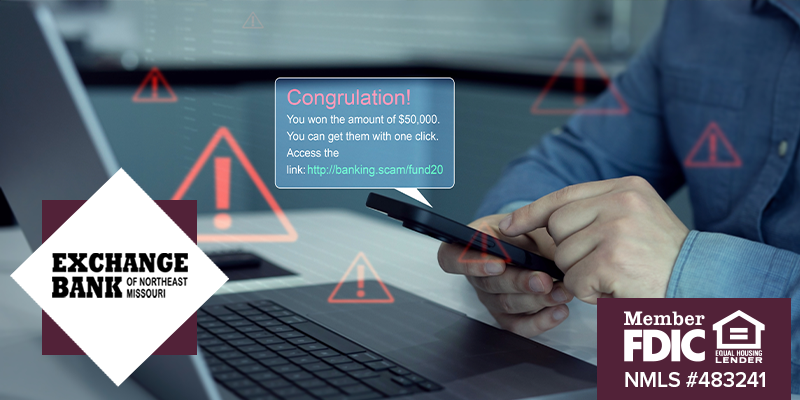EBNEMO
Updated Tue September 16, 2025
Published Under: Cyber Security Personal Finances Save Money

Your phone buzzes. The message says: “FedEx: Package undeliverable. Click here to reschedule.” Or maybe: “Toll Notice: Balance due. Pay immediately.”
Looks convincing, right? This is what’s known as smishing, a scam text designed to trick you into clicking, sharing information, or even handing over access to your bank account.
At Exchange Bank of Northeast Missouri, we want our community to stay one step ahead. Here’s a clear guide on what smishing looks like, how to protect yourself, and what to do if you’ve already clicked.
What Is Smishing?
Smishing is simply “SMS phishing.” It’s when scammers send fraudulent text messages pretending to be companies you trust: delivery services, toll agencies, banks, or even the IRS.
The goal is the same every time: create urgency, push you to click a link, and capture your sensitive information.
Read More: What is Phishing?
The Texts We See Most Often
Here are some of the most common scam texts that have been going around lately:
- Fake delivery notices: “FedEx/UPS: Your package can’t be delivered. Pay $1.25 to release.”
- Unpaid tolls/tickets: “Immediate payment required to avoid penalties.”
- Government impersonation: “IRS: Final notice. Pay now or face action.”
- Bank alerts: “Suspicious activity detected. Log in here to verify.”
- Verification code scams: They trick you into sharing one-time passcodes they triggered.
Related: Cybersecurity Awareness Month: 7 Security Tips for Your Bank Info
Signs a Text Message Might Be a Scam
Keep your eye out for some of these red flags in text messages:
- Misspellings or strange grammar
- Weird or shortened web links
- Generic greetings like “Dear Customer”
- Pressure to act immediately
- Requests for PINs, passwords, or codes
What to Do if You Get a Suspicious Text
Here’s what to do if you receive a suspicious text:
- Don’t click any links.
- Don’t reply. Even “STOP” or “UNSUBSCRIBE” may confirm your number to them.
- Verify separately by opening the company or bank app, or by calling the number on your bill or bank website (not from the text)
- Delete the text once you’ve confirmed it’s fake.
- Report it: forward to 7726 (SPAM) and file at reportfraud.ftc.gov.
Already Clicked? Here’s Your Recovery Plan
Don’t panic. Follow these instructions if you’ve already clicked:
- Change any passwords or PINs that might have been compromised.
- Scan your phone/device for malware or suspicious apps.
- Contact EBNEMO right away so we can help protect your accounts.
- Keep an eye on your bank statements for odd transactions.
Contact Exchange Bank of Northeast Missouri
How EBNEMO Protects You
Here’s what we will never do by text:
- Ask for your full account number, PIN, or password
- Send you a link to log in or verify information
- Request remote access to your device
- Demand immediate transfers to “safe accounts”
If you’re unsure, call us directly using the number on our website or the back of your debit card. We’ll always be glad you double-checked.
Stay Scam-Savvy
Smishing is sneaky, but it doesn’t have to catch you off guard. Remember: pause before you click, verify with official sources, and call us if you’re ever in doubt. Together, we can protect not only your money, but your peace of mind.
Find More Security Resources Online
Member FDIC, Equal Housing Lender, NMLS#EBNEMO
Comments